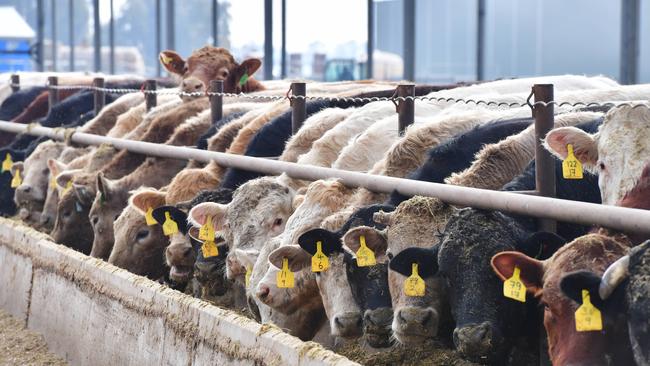Australian feedlots produce less greenhouse gas emissions than previously thought
New research shows the 1970s model used to measure greenhouse gas emissions from cattle feedlots has been significantly overstating emissions.

Greenhouse gas emissions from beef cattle feedlots are likely significantly lower than stated in official carbon accounting data, with new research finding that fattening cattle on grains could be a carbon mitigant.
New research suggests the model used to estimate emissions, based on a 1970s study of US dairy cows, was likely to be overstating emissions from cattle in feedlots by about 40 per cent.
The research, funded by Meat and Livestock Australia and conducted by several Australian universities, has been submitted to the federal government and could result in changes to the National Greenhouse Gas Inventory.
MLA feedlot program manager Matt Van der Saag said the findings were significant for the $4.6bn feedlot industry. “It’s positive for lotfeeders,” he said. “It is showing emissions are lower than what is currently stated.
“It reaffirms what other people globally recognise, which is that grain feeding, in itself, is effectively a greenhouse gas mitigant.”
Mr Van der Saag said the research, the latest of which was done by the University of New England in NSW, indicated feeding grain to cattle increased the efficiency of their stomachs, known as rumen, and changed the internal microbiome.
He said new technology enabled the researchers to more accurately measure emissions than that used in 1979 to formulate the “Moe and Tyrell” method. It was also influenced by a different composition of grain fed to Australian cattle that resulted in less methane emissions.
The researchers also came up with a new equation to extrapolate findings and measure overall emissions with more precision.
“As technology has improved over time, our measurements have become more accurate and now we have been able to prove it,” Mr Van der Saag said.
If the federal Department of Climate Change, Energy, the Environment and Water accepts the proposed new methodology, it will be sent to the Intergovernmental Panel on Climate Change for approval.
Feedlotting in Australia has traditionally been less common than in the USA and Europe but has increased in recent years as a means of drought proofing and to speed up fattening rates in cattle. About 4 per cent of the national beef cattle herd is being fed grain at a feedlot at any one time.
It still represents only a small fraction of the beef industry’s stated greenhouse gas emissions, most of which is attributed to methane emissions from the grass-fed sector.
Methane is produced in the rumen when plant matter breaks down.
Graziers have been working with researchers and start-ups to find ways to introduce supplements to the feed of their stock in rangeland properties to reduce methane emissions from their livestock.
But there is ongoing disagreement among scientists and policymakers about whether there should be a distinction between biogenic methane emitted by livestock, which already exists in a balanced cycle in plants and soil and the atmosphere, and methane emitted from sources stored deep underground for millennia.
CHARLIE PEEL




To join the conversation, please log in. Don't have an account? Register
Join the conversation, you are commenting as Logout